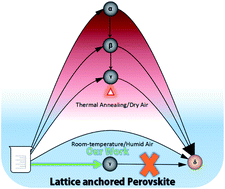Degradation induced lattice anchoring self-passivation in CsPbI3−xBrx†
Abstract
The all-inorganic halide perovskite (CsPbI3) holds promise for photovoltaic applications but suffers from a detrimental phase transformation to a non-perovskite phase δ-CsPbI3 at low-temperature. Of the different perovskite polymorphs, there has been a wide range of studies on γ-CsPbI3 due to its kinetic stability at near room-temperature. However, synthesis routes to this and other all-inorganic halide perovskites are still not ideal, requiring uneconomical elimination of humidity as well as quenching from elevated temperature. Water/moisture is commonly meticulously avoided due the fact that it can accelerate the detrimental degradation of the perovskite. In our synthesis, we used an alternative approach of engineering an in situ degradation process to form a dual-functional PbI(OH) protective covering and succeeded in performing the first room-temperature synthesis of γ-CsPbI3 under ambient humidity. The vastly improved stability benefits from both lattice anchoring and physical coverage of γ-CsPbI3 by an ultra-thin PbI(OH) layer. The resultant γ-CsPbI3 is stable for more than 2 months under ambient conditions (25 °C, RH = 30–60%) and more than 12 hours at 175 °C in air without any degradation. Furthermore, we show that this novel facile method can be successfully applied to mixed halide perovskites such as CsPbI2Br, and this has allowed the first experimental synthesis of the γ-polymorph of CsPbI2Br. Thus, our work provides an efficient degradation-induced lattice-anchoring self-stabilization strategy and a new avenue to the economical synthesis of all-inorganic perovskite materials at room-temperature under ambient conditions.

- This article is part of the themed collection: Celebrating our 2021 Prizewinners


 Please wait while we load your content...
Please wait while we load your content...